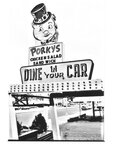By Jan Willms
University Avenue and its history from the 1880s to modern times are depicted in the latest book by Iric Nathanson, “University Avenue of the Twin Cities.”
The book, full of photographs and narration, was something of a challenge, according to Nathanson, who has been writing about local history for the past 25 years and lives in Longfellow.
“I covered both the Minneapolis and St. Paul ends of University Avenue, which plays an important role in connecting the two cities,” he said. “This is partly a story as well as a picture book, and combining the two together can be challenging,” Nathanson explained. This is his fifth book in a series of pictorial histories published by Arcadia.
“Arcadia is very easy to work with, and they do a very good job of marketing the books,” Nathanson said. “And I can pretty much write about what I want.”
He said he needs to gather 150 historical photos for each book. “It mostly involves tracking down photos from the Minnesota Historical Society,” Nathanson stated. He also utilized the Ramsey County Historical Society and Hennepin Library.
“I track down photos and write some narrative and captions for each of the photos,” Nathanson explained. “I take some of the current photos myself – I know how to point and shoot a camera,” he joked.
Nathanson said it takes him about a year to complete the Arcadia books. “You have to get high quality photos, and it’s a challenge to find historical photos that are interesting and have a high focus,” he said.
“I started out this book with sort of an idea of what I wanted to do,” Nathanson said. “It took a while to figure out. In the book, I have separate chapters on the University of Minnesota and the State Capitol. In this case, putting together a narrative proved a little tricky. A large section of the avenue runs through the campus.
“University Avenue has a particularly interesting story to tell,” Nathanson continued, “because fortunes have risen and fallen.” He said that for the past 10 years, University Avenue in both Minneapolis and St. Paul has been the site of a huge amount of construction.
“Even with those changes, quite a few historic places remain, which gives the avenue a settled feeling,” he noted.
Nathanson said there are some businesses along University Avenue that have survived though the years. “One good example in Minneapolis is Jax Café, which dates back to the 1920s. It’s still family-owned and a real destination. It established itself as an important institution and has received strong support from the community,” Nathanson stated.
“St. Paul businesses have come and gone, but many of the buildings have survived,” Nathanson added. “At 280 and University, the International Court started out as an auto assembly plant during World War I.”
Although the Minneapolis end of University Avenue has major intersections zoned for high rises, such as 25-story apartment buildings, many original buildings remain from the 1940s.
What has disappeared from University Avenue, however, is the large number of car dealers that once competed there. “It was called Auto Row in St. Paul, but that era has come and gone with the construction of I-94,” Nathanson said.
According to Nathanson, immigrants from Southeast Asia have had a huge impact on the Saint Paul side of University Avenue. “They saved the avenue, which was having difficult times after I-94 opened. They came in, started businesses and the rents, like along Lake Street, were fairly low. The problem now is how to enable these businesses to survive now that rents along University Avenue are going up.” Nathanson said he had some direct experience with University Avenue himself when he was with a nonprofit that worked with businesses affected by the light rail. “We administered grant programs in 2014 and 2015, and it sparked my interest in University Avenue,” he said.
Nathanson has done a number of different things during his career. His first job after college was as a community organizer in south Minneapolis. He worked in Washington for a Minneapolis congressman and on a project with Native Americans while the American Indian Movement (AIM) was starting. He was employed by a Minneapolis development agency for 25 years, and worked for Don Fraser. And then he started writing.
“I started out writing about Minneapolis history, but then expanded to covering Minnesota,” he noted. He said he has been writing for the past 25 to 30 years, and regularly contributes to the Monitor’s sister newspaper, the Longfellow Nokomis Messenger.
“I don’t really call myself an historian,” Nathanson remarked. “I’m not an academic. I write about history. I sort of try to tell stories where history and journalism intersect.”
Nathanson said University Avenue has a story that needs to be told. He cited some of the landmarks like Montgomery Wards, Porky’s and the Lexington Ballroom that once graced the avenue. “I view this (book) as an historic preservation effort.”
Nathanson is working on another book in his series, “Minneapolis Lakes,” which will be published in the spring of 2024.


Comments
No comments on this item Please log in to comment by clicking here